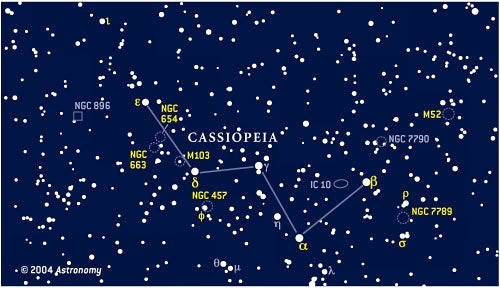Eta (η) Cassiopeiae: a colorful yellow and red duo (magnitudes 3.4 and 7.5, separation 13″), situated a few degrees northwest of Alpha Cas. It’s a fine sight at 100x.
Iota (ι) Cassiopeiae: a triple star whose magnitude 4.6 primary is accompanied by stars of magnitudes 6.9 and 8.4 at distances of 2.5″ and 7.2″, respectively. The magnitude 6.9 companion may be hard to see in small scopes. Try 100x or more.
M52: a rich, condensed open star cluster whose approximate location is found by tracing a line from Alpha through Beta (β) Cassiopeiae, and extending it an equal distance beyond. Look for a sprinkle of stars surrounded by the nebulous glow of unresolved cluster members. My best view was with 100x.
M103: a small, somewhat sparse cluster located just a degree from Delta (δ) Cassiopeiae. The surrounding area contains a number of clusters, including NGC 663 and NGC 654. NGC 663 is a rich oval-shaped group that, to me, is more visually attractive than M103. NGC 654 appears as a small, faint glow, and 100x works best to capture a good view of this cluster.
Also in the field is Trumpler 1 (a.k.a. the “Zipper Cluster”). This neat little star group was shown to me by Amherst, Massachusetts, amateur John Davis at the Astronomer’s Conjunction in Northfield, Massachusetts, a few summers ago.
In July, I discussed the value of astronomy conventions (“Astro-socializing,” July 2004). Getting to tap the knowledge bank of veteran observers like John is one reason I attend these gatherings. If you are at Stellafane in Springfield, Vermont; the Astronomer’s Conjunction; or Arunah Hill Days in Cummington, Massachusetts, next year, look for John Davis and ask him to show you the “Zipper Cluster.”
NGC 7789: a large, rich cluster found midway between Rho (ρ) and Sigma (σ) Cassiopeiae. This cluster appears as a ghostly glow sprinkled with fine stardust. Use low power.
NGC 457: neat cluster! Some observers liken its appearance to an owl, with the bright, wide double star Phi (φ) Cassiopeiae forming the glowing eyes and outwardly branching rows of stars creating the wings, body, and tail. I saw an alien, with the owl’s wings looking more like spindly arms. What do you see?
In August, I wrote that M57 (the Ring Nebula) appears annular “only through 6-inch scopes or larger” (“A ring and a triangle,” August 2004). This prompted an e-mail from Arizona amateur Bill Delinges, who noted he has seen the “ring” with both a 4-inch reflector and 100mm binoculars. When I describe the appearance of a sky object, I consider its visibility to the eyes of the typical reader of this column — a novice, using ordinary equipment, under average sky conditions. For such an individual, seeing the “ring” with a telescope smaller than 6 inches in aperture would be difficult, if not impossible. Bill, I’d love to skygaze from your Arizona skies!
Next month: some holiday gift ideas. Clear Skies.











